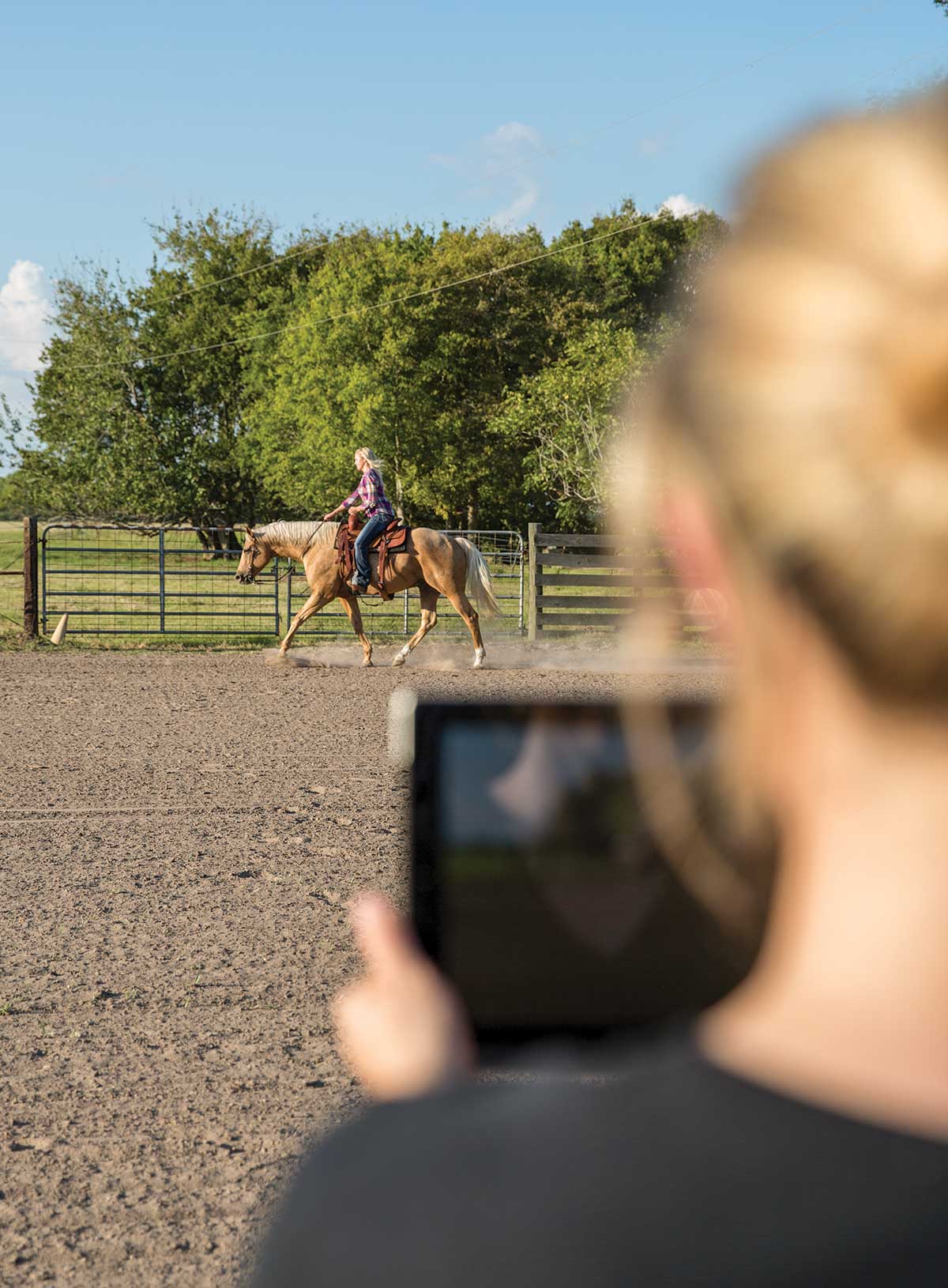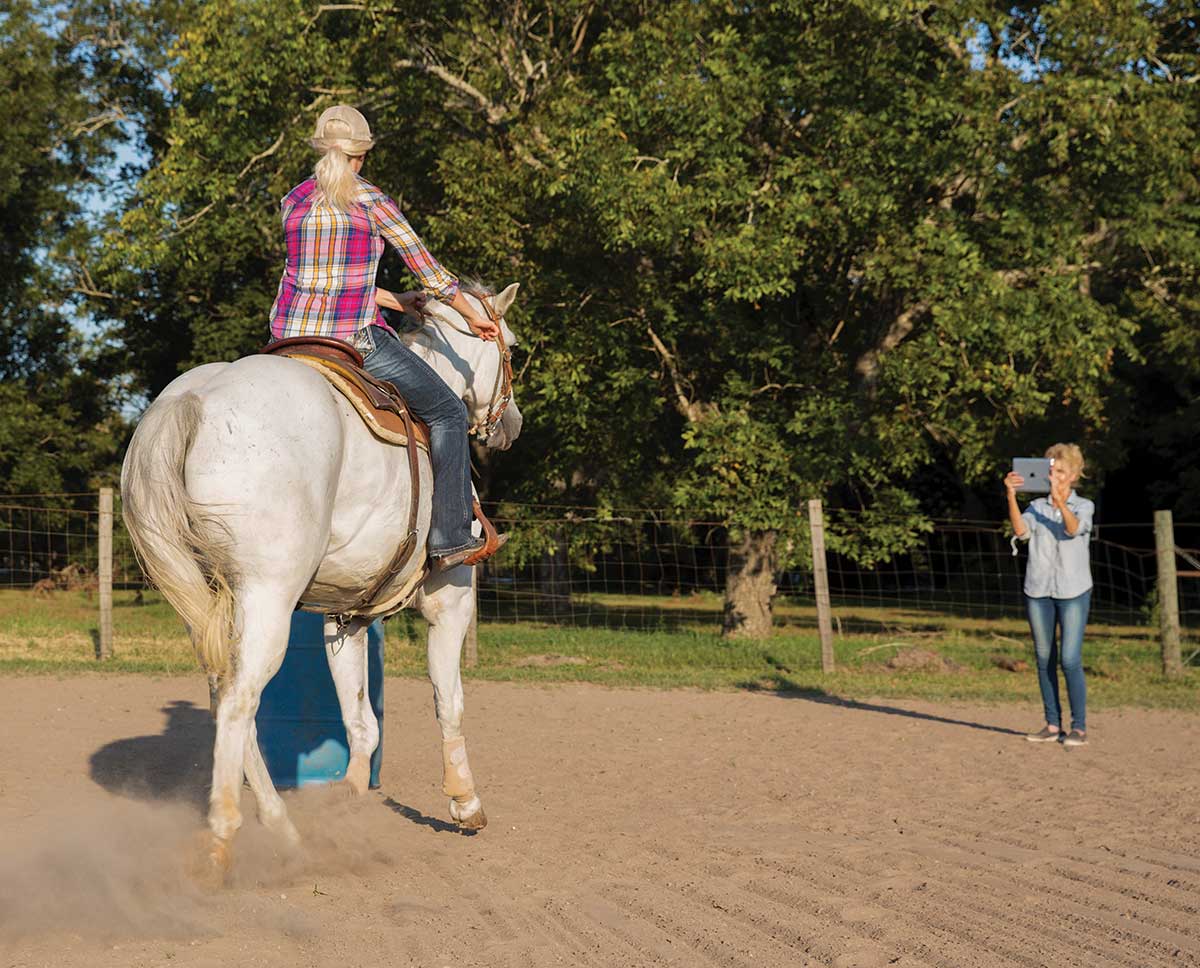
With easy-to-access options for video coaching, your search for expert training assistance requires only three things: a video-recording device, a friend to assist, and an internet connection. Seem too easy to be true? Maybe not!
“Ideally, you’d get lessons in person with a coach you respect,” says Ty Hillman of
preparetowin.tv and husband of professional barrel racer Stevi Hillman. “However, that’s not an option a lot of the time, so getting video critiques is the next best thing.”
Through video coaching, you can remove the logistics of hauling great distances to access a reputable coach who provides the kind of instruction or critique you desire, such as Stevi or multiple world champion and noted coach Al Dunning.
Stevi draws on her experience as barrel horse trainer and competitor to provide expert critiques on runs, while her husband, Ty, provides personal coaching to help riders and competitors achieve their goals. In 2016, Stevi qualified for the Wrangler National Finals Rodeo and sits second going into the 2017 WNFR.
Dunning provides consultation through Team AD at aldunningsteamad.com. He’s coached horses and riders to more than 45 world and reserve world champion titles in multiple associations, including the National Reining Horse Association, National Cutting Horse Association, and the National Reined Cow Horse Association. He says riders from all disciplines, and even colt starters, are looking for ways to improve. The power of the internet allows you to come to Dunning, even if you’re miles away from Arizona.
“I coach people just beginning to ride, professionals looking to improve, and all levels in between,” Dunning says. “I coach riders for ranch versatility, cutting, and Western riding, as well as trail riders looking to gain more control. I can help the whole gamut of riders.”
“At a lower level of riding, I can tell you how to make your horse better,” Dunning asserts. “I also look at tack and gear, how you’re using it when riding, how the horse responds—I leave no stone unturned to help you get better.”
Looking to score higher on a pattern run? Want to shave seconds off a barrel pattern? Video consultation and coaching can help. Even if you’re not a competitor, a video coach can help you have a safe, controlled horse in any situation. Use these tips from the Hillmans and Dunning to get the most out of your virtual video coaching session.
Learning Styles
Clinic settings can be intimidating. You might fear making a “rookie mistake” in front of your training idol and other clinic-goers. In a large-group setting, you might not receive in-depth, one-on-one instruction. Rather than retreating to your home barn, you can turn to video coaching.
With a video that focuses on one horse (yours) and one rider (you), the critique is personalized.
“A coach can help you by seeing things you do that are counterproductive to helping you achieve your goals,” Ty shares. “While everyone has their own unique coaching style, and coaches all have their own opinions, there are universal points a coach can identify that could hold you back or are the base of an issue.”
Sending a video of yourself riding to a respected mentor can feel risky. The key is to view mistakes caught on film in a positive light.
“The biggest problem I have is that people worry about what they send me,” Dunning says. “I try to make it clear that you don’t need to practice to send a video. I want to see the first take! I don’t want to see an edit; I want to see your major mistakes. That’s how I can talk you through it and help.”
Even if you ride with a coach at home, a video critique could get you past a roadblock. Dunning offers the option for both you and your coach to be critiqued while riding your horse. He reviews the footage to see if there’s a missing component in your horse. It’s another set of eyes to offer guidance.
If video coaching looks like a great learning opportunity, our experts say to first find an instructor who matches your riding discipline or style. Look for videos of the expert riding or training to get an idea of their techniques.
“Find someone you trust; someone whose riding you admire. Then work with them,” Stevi says. “The problem I see is too many people offering different advice to one person. It’s good to get help, but be careful not to get too much advice from too many sources.”
Once you identify the ideal expert, take the next step and contact him or her for coaching.

Behind the Scenes
There are a number of online video coaching opportunities for equestrians, and each expert offers a different method of evaluation. Some require a subscription to an online learning package, while others offer single-video lesson plans. Some experts receive and return videos publically for all to see, and others share privately. Pick a package that suits you.
Both of our experts receive videos privately. Dunning sets up a private YouTube account for his video coaching clients.
“There are a few reasons I do it this way, and first is that they’re paying for information from me, so I’m not going to share it publically where anyone can take advantage,” he says. “Second, this method spares embarrassment if you’re sensitive. I like the rough videos that show the mistakes. The whole world won’t see the video, just old Al. And I’ve seen a lot over the years!”
Dunning records his comments over your video footage so you can hear his critique in real time as you make mistakes.
Stevi, who competes on the road most of the year, uses a couple of methods to review runs and provide critiques in a timely manner. A barrel run lasts just a few seconds, but her advice can extend far beyond the videoed run.
“We ask you to fill out a questionnaire and email it to us along with a few videos,” she says. “I have an app on my phone that allows me to voice-over the runs, and I can rewind and watch in slow motion. I’ve also written longer email critiques.”
This combination of visual learning and extended advice provides a complete coaching package.
An added bonus: You can access the critique over and over. View it before, during, or after a riding session on a mobile device. And, if you fall back into an old routine, the coaching is available to get you back on track.
Tech Support
You don’t need a professional videographer to submit a video for critique; just a friend with a video-recording device who has time to capture your ride. Use these tips from our experts to record a video that will garner the most helpful evaluation.
1. Pick a Place and Time
Shoot outside, if possible. If you must ride in a covered arena, take the video when the arena is well-lit.
“Filming in covered arenas presents challenging videos to view because they are usually dark underneath the roof and the background is extremely bright,” Stevi says.
Whether outside or under cover, position the videographer with the light to her back to optimize video exposure. Look for the time of day when the light has the least shadows on the horse and rider, generally early mornings and evenings.
2. Set Up the Camera
Always shoot horizontally. Holding the device vertically creates “dead space” at the top and bottom and a narrow view. When uploaded to YouTube, black bars will be added to the image to fill the space.
Dunning also suggests finding a way to steady the camera.
“There are some handheld devices that keep a phone or iPad steady and level,” he says. “Use a tripod or something else to steady the camera.”
Another consideration is the best shooting angle to show your feet and hands. Dunning says to tell your videographer to look at you from the center of the arena, with you riding around the camera. Also, he suggests videoing from a viewing platform looking down, or squatting down to aim the camera up.
3. Zoom In
Instincts or lack of video experience might lead your videographer to hold the same view throughout the video, no matter how close or far you are to the camera. This can be problematic for the coach providing critique.
“I receive many videos that look like they were filmed 50 yards from the arena,” Ty says. “Zooming can be limited on a tablet or phone, but if the arena is large and the person is standing in the alley, its challenging to see details.”
Ask your videographer to practice zooming along with you as you complete a pattern, be it a reining run or a cloverleaf around the barrels. If zooming distorts the video, your videographer should change position so the key components of your ride are clearly seen.
4. Submit
How you submit the video to the coach affects video quality.
Dunning has clients upload to a YouTube page, whereas the Hillmans prefer email. Sending a video via text will lower the resolution, making it hard to clearly see the horse and rider.
Video length will also impact how it can be sent. If you’re sending a working cow horse video, it may be best to break the portions—reining pattern and boxing/fence work—into two short videos instead of one long file.






